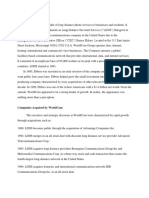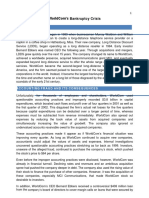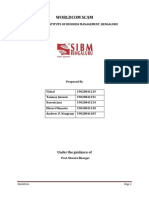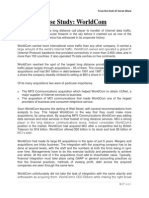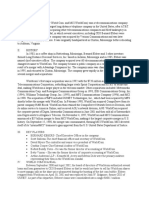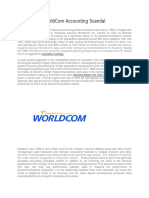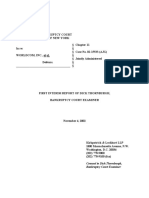WorldCom’s Bankruptcy Crisis
INTRODUCTION
The story of WorldCom began in 1983 when businessmen Murray Waldron and William Rector
sketched out a plan to create a long-distance telephone service provider on a napkin in a coffee
shop in Hattiesburg, Miss. Their new company, Long Distance Discount Service (LDDS), began
operating as a long distance reseller in 1984. Early investor Bernard Ebbers was named CEO the
following year. Through acquisitions and mergers, LDDS grew quickly over the next 15 years. The
company changed its name to WorldCom, achieved a worldwide presence, acquired
telecommunications giant MCI, and eventually expanded beyond long distance service to offer the
whole range of telecommunications services. WorldCom became the second-largest long-distance
telephone company in America, and the firm seemed poised to become one of the largest
telecommunications corporations in the world.
Chronology of Developments
In 1983, the company was established under the name of “Long Distance Discount Service”.
In 1995, it started to implement a growth strategy by acquiring smaller businesses.
In the same year, the name of the company was changed to Worldcom.
It made a merger with MCI Communications Corporation in 1998 and as a result of this merger, it started
to operate on wireless phone services.
In the early 2000s, it became the second largest telecommunications company in the United States.
In 2002, an accounting scandal emerged within the company. It has been determined that the
accounting records and financial statements did not reflect the real financial position of the company.
The size of the aforementioned accounting scandal, which was detected by the internal auditors of the
institution, is that the revenues are shown to be more than approximately USD 11 billion.
It filed for bankruptcy in July 2002.
After the bankruptcy announcement, approximately twenty thousand employees of the enterprise were
unemployed.
Upon the detection of irregularities within the company, the auditors and managers were sentenced to
various penalties.
Long Distance Discount Service, which operated in the telecommunication sector, faced a large amount
of debt in a short time after its establishment in 1983. In order to correct the current negative situation,
Bernerd J. Ebbes, who had no experience in technology and one of the partners who founded the
company, has been appointed as the CEO. In addition to fulfilling his full-time CEO role at Worldcom,
�Ebbes was both a business owner and a manager in many different sectors. Ebbes, especially since 1995,
has been successful with the growth strategy he has adopted by acquiring small-scale companies and has
achieved a rapid growth. The company enlarged its scale by performing numerous mergers and
acquisitions between 1989 and 1995 and became an institution operating in different geographies. As a
result of this change and growth, it was decided to change the name of the company to Worldcom in
1995. In the following years, Worldcom's growth strategy and company acquisitions continued, and in
1998 it became a large-scale international corporation with an income of approximately USD 27 billion
and operating with 79,000 employees. The company was not satisfied with this, it continued to grow by
continuing its acquisition strategy and the value of its stocks remained at high levels. Its market value in
1999 was USD 115 billion. By 2002, with the radical growth strategy of Ebbes, Worldcom had become an
international corporation operating in approximately 65 countries and being the fourth largest company
in the telecommunications sector according to the Fortune 500 list.
As of this date, Worldcom was operating in the following two main segments
1. Worldcom Group Activities
The company activities under this group can be summarized as follows:
International communication services,
Data services,
Internet-related services (website management, digital subscriber lines, virtual private networks,
other Internet-related services),
Design, implementation and management of communication systems.
2. MCI Group Activities
This group includes activities related to wholesale and retail communication services. Considering the
Group's financial data for the year 2000, the revenues from the activities in this category constituted
41.8% of the total revenue. The starting point of Worldcom's collapse can be taken as 1998, when the
value of the company's stocks began to decline from its last quarter. On the other hand, in the three-year
period between 2000-2002, the company managed to maintain its position among the top five companies
in the telecommunications sector, based on the Fortune 500 list.
In 2000, the telecommunications sector in the world started to slow down, Worldcom lost some of its
important customers, and its revenues decreased and its indebtedness increased. The company's collapse
began to accelerate after regulatory. authorities prevented Worldcom from acquiring Sprint
Communications in 2000. In 2002, an investigation was launched by the Securities Exchange Commission
into a debt of approximately USD 400 million, which CEO Ebbes borrowed from Worldcom at a very low
interest rate of 2.15% and used to pay off his personal debts secured by the company's shares. In April
2002, Ebbes resigned from his position on the condition that his loans be restructured and he was paid
USD 1.5 million annually for life. As a result of the examination of the company's accounting records by
the vice president responsible for internal audit, who was appointed by the new CEO, some errors and
irregularities were detected. Upon the irregularities detected in the accounting records, the assistant
general manager responsible for financial affairs was dismissed and the accounting manager of the
company resigned.
�The biggest scandal related to Worldcom emerged in June 2002. In this period, the company made a
statement that the profit figures in its financial statements published in the past were not correct and
would correct them. In order to make the loss-making company appear to be making a profit, the
management of the company resorted to financial statement fraud by improperly accounting for expenses
and over-representing revenues. With the effect of accounting fraud, it has been revealed that the assets,
income and expenses of the company did not reflect the truth. As a result of making the necessary
corrections, it has been understood that the profit announced by Worldcom in the financial statements
of 2001 and the first quarter of 2002 did not actually exist, and the company made a loss in these periods.
As a result of these events, in July 2002, the company declared bankruptcy.

